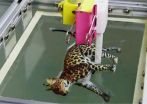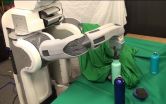New computational technique advances color 3D printing process
Researchers at Columbia Engineering and Zhejiang University in China develop new method -- computational hydrographic printing -- that physically aligns a surface color texture onto a 3D surface with a precision never before attained
2015-05-22
(Press-News.org) New York, NY -- May 22, 2015 -- Working with researchers at Zhejiang University in China, Changxi Zheng, assistant professor of computer science at Columbia Engineering, has developed a technique that enables hydrographic printing, a widely used industrial method for transferring color inks on a thin film to the surface of manufactured 3D objects, to color these surfaces with the most precise alignment ever attained. Using a new computational method they developed to simulate the printing process, Zheng and his team have designed a model that predicts color film distortion during hydrographic immersion, and uses it to generate a colored film that guarantees exact alignment of the surface textures to the object. The research will be presented at SIGGRAPH 2015, August 9 to 13, in Los Angeles.
"Attaining precise alignment of the color texture onto the surface of an object with a complex surface, whether it's a motorcycle helmet or a 3D-printed gadget, has been almost impossible in hydrographic printing until now," says Zheng. "By incorporating -- for the first time -- a computational model into the traditional hydrographic printing process, we've made it easy for anyone to physically decorate 3D surfaces with their own customized color textures."
Used in mass production for transferring repeated color patterns to a 3D surface, hydrographic printing can be applied to various materials including metal, plastic, wood, and porcelain. The process uses a PVA film with printed color patterns placed on top of water. An activator chemical is then sprayed on the film, softening the color film to make it easily stretchable. Next, a physical object is slowly dipped into the water through the floating film. Once the film touches the object, it gets stretched, wrapping the object's surface, and adhering to it. Throughout the process, the color ink printed on the PVA film is transferred to the surface. But the process has a fundamental limitation in that it is almost impossible to precisely align a color pattern to the object surface, because the object stretches the color film. With complex surfaces, the stretch can be severe and even tear the film apart.
"So current hydrographic printing has been limited to transferring repetitive color patterns," Zheng explains. "But there are many times when a user would like to color the surface of an object with particular color patterns, to decorate a 3D-printed mug with specific, personalized images or just to color a toy."
Building upon previous work on fluid and viscous sheet simulation also done at Columbia Computer Graphics Group, Zheng has developed a new viscous sheet simulation method to model the color film stretch during the hydrographic printing process. This model predicts the stretch and distortion of color films and creates a map between the locations on the film and the surface locations to which they are transferred. With the map, he can compute a color image for printing on the PVA film and then, after the hydrographic immersion, it forms the desired color pattern on the object's surface.
To prove that this simulation works, Zheng and his collaborators in China used off-the-shelf hardware to build a calibrated system in which a mechanical apparatus precisely controls the object immersion, and a 3D-system measures the object orientation and its dipping location. With the incorporation of Zheng's simulation model, they were able to compute a color image to feed into their hydrographic system for precise texture registration. To avoid severe film distortion and the danger of the film tearing, they introduced a multi-immersion design: the object can be dipped multiple times, each with a different orientation and a film printed with a different color pattern. The computation of color patterns allows the transferred colors from individual immersions to be combined into the desired "final" surface decoration.
"This system is easy to set up for personal use and it's quite inexpensive, less than 40 U.S. cents per printing," Zheng notes. "And it works for a wide range of complex surface geometries and materials."
He adds, "This was a challenging but fun project. I'm very interested in the interaction between the virtual world and the real world, and this research is a good example of how virtual-world computation can work hand-in-hand with a real-world manufacturing process and significantly improve the production quality."
INFORMATION:
This research was supported in part by the National Science Foundation in the U.S. and in China, as well as generous gifts from Intel.
PAPER: http://www.cs.columbia.edu/cg/hydrographics/
VIDEO: https://www.youtube.com/watch?v=YlUhPrAqiY0
[Attachments] See images for this press release:


ELSE PRESS RELEASES FROM THIS DATE:
2015-05-22
(NEW YORK - May 22) - By comparing flu viruses to the virus that causes measles, researchers fine-tuned a tool that may enable faster vaccine design, according to a study led by Mount Sinai researchers and published online this week in the journal Cell Reports.
The study results revolve around viruses, which are designed perfectly by evolution to invade human cells, inject viral genes and use human genetic machinery to make copies of them. In an endless back and forth, human immune cells have evolved to recognize and attack viral surface proteins, and viruses to constantly ...
2015-05-22
(PARIS, FRANCE) Technique, talk, and talent were three buzzwords at the 2015 EuroPCR congress. As in years past, the conference featured a mix of breaking news, live case demonstrations, oral and poster sessions, debates, and tips-and-tricks tutorials. New study data have been increasingly showcased at EuroPCR and this year's meeting featured over 70 new abstract sessions throughout the four-day meeting, across five interventional tracks.
One of the focus topics at this year's meeting was a spate of recent trials showing a benefit for mechanical thrombectomy in acute ...
2015-05-22
URBANA, Ill. - The widespread evolution of herbicide-resistant weeds is costing farmers, especially through decreases in productivity and profitability. Although researchers and industry personnel have made recommendations to slow this evolution, an understanding of the patterns and causes of the resistance has been limited.
Diversifying the herbicide mechanisms of action (MOAs) has been recommended to stop the spread of herbicide-resistant weeds. MOAs refer to the biochemical interaction that affects or disrupts the target site in the weed. Two common methods of diversifying ...
2015-05-22
The first definitive summary of the best and safest blood pressure lowering treatments for kidney disease and diabetes patients has been compiled by New Zealand doctor and researcher Associate Professor Suetonia Palmer.
The international relevance of her work for doctors, patients and those who decide which drugs to fund has been demonstrated by the prestigious Lancet medical journal publishing an article on her study in its latest edition.
The University of Otago, Christchurch, researcher together with a global team used innovative statistical analysis to compare hundreds ...
2015-05-22
Berkeley -- Researchers at the University of California, Berkeley, have developed algorithms that enable robots to learn motor tasks through trial and error using a process that more closely approximates the way humans learn, marking a major milestone in the field of artificial intelligence.
They demonstrated their technique, a type of reinforcement learning, by having a robot complete various tasks -- putting a clothes hanger on a rack, assembling a toy plane, screwing a cap on a water bottle, and more -- without pre-programmed details about its surroundings.
"What ...
2015-05-22
WASHINGTON, D.C., May 22, 2015 -- Play a flute in Carnegie Hall, and the tone will resonate and fill the space. Play that same flute in the Grand Canyon, and the sound waves will crash against the rock walls, folding back in on each other in sonic chaos. The disparity in acoustics is clear - to the modern listener, the instrument belongs in an auditorium.
"Distinct echoes would be totally unforgivable in today's performance spaces," says Steven J. Waller, an archaeo-acoustician who has studied prehistoric rock art and the acoustics of ancient performance spaces. "But, ...
2015-05-22
WASHINGTON, D.C., May 22, 2015 -- The room is loud with chatter. Glasses clink. Soft music, perhaps light jazz or strings, fills the air. Amidst all of these background sounds, it can be difficult to understand what an adjacent person is saying. A depressed individual, brought to this cocktail party by a well-meaning friend, can slide further into himself, his inability to hear and communicate compounding his sense of isolation.
"A lot of research has suggested that these people with elevated depression symptoms have a bias towards negative perception of information ...
2015-05-22
Why do good people do bad things? It's a question that has been pondered for centuries, and new research published by the Society for Personality and Social Psychology may offer some insights about when people succumb to versus resist ethical temptations.
"People often think that bad people do bad things and good people do good things, and that unethical behavior just comes down to character," says lead research author Oliver Sheldon, PhD. "But most people behave dishonestly sometimes, and frequently, this may have more to do with the situation and how people ...
2015-05-22
Parasitic worms can pose a serious threat to the Dungeness crab, a commercially important fishery species found along the west coast of North America. The worms are thought to have caused or contributed to the crash of the crab fishery of central California during the last half century. New research shows that infected crabs can rid themselves of parasites by moving into the less salty water of estuaries. Low salinity kills the worms creating a parasite refuge for the crabs.
The large Dungeness crab (Metacarcinus magister) is an important source of income for fishermen ...
2015-05-22
Ecologists from the University of York, together with the Wildlife Conservation Society (WCS) and the Uganda Wildlife Authority (UWA), have developed a new method to better identify where poachers operate in protected areas.
Published in Conservation Biology, the analysis provides spatial maps of illegal activities within Queen Elizabeth National Park, one of Uganda's most important protected areas for elephant conservation.
Analysing 12 years of ranger-collected data, different types of threats were monitored and recorded, including the commercial hunting of large ...
LAST 30 PRESS RELEASES:
[Press-News.org] New computational technique advances color 3D printing process
Researchers at Columbia Engineering and Zhejiang University in China develop new method -- computational hydrographic printing -- that physically aligns a surface color texture onto a 3D surface with a precision never before attained


